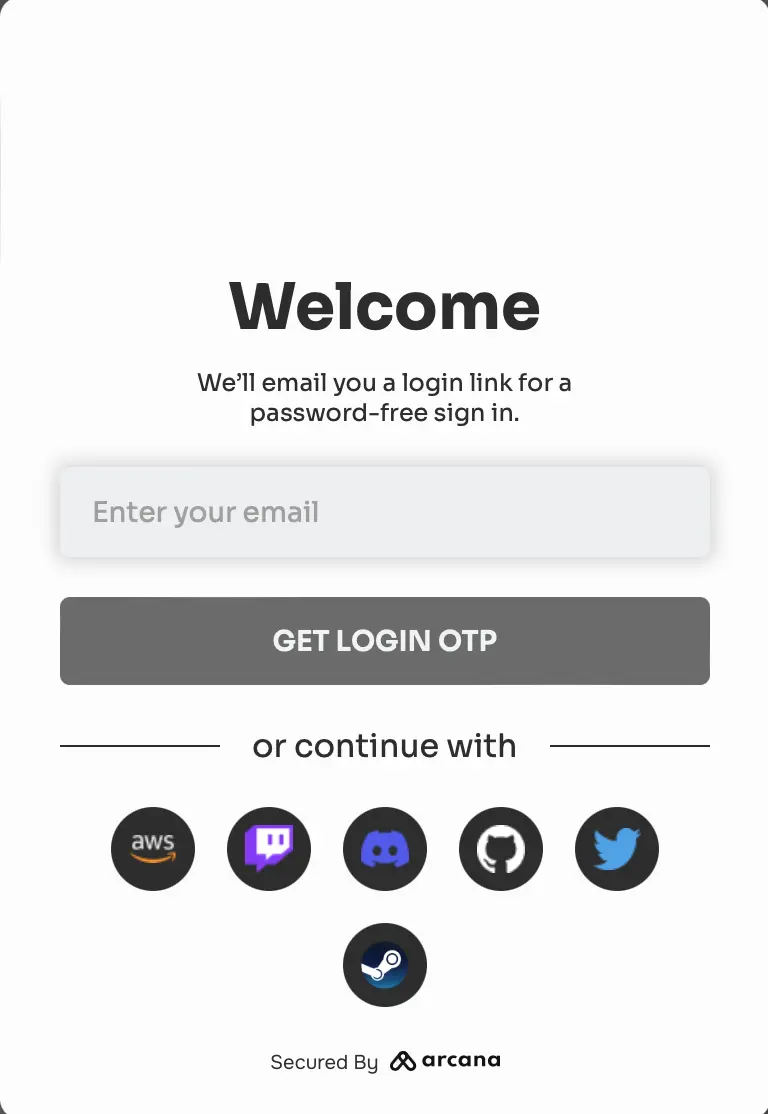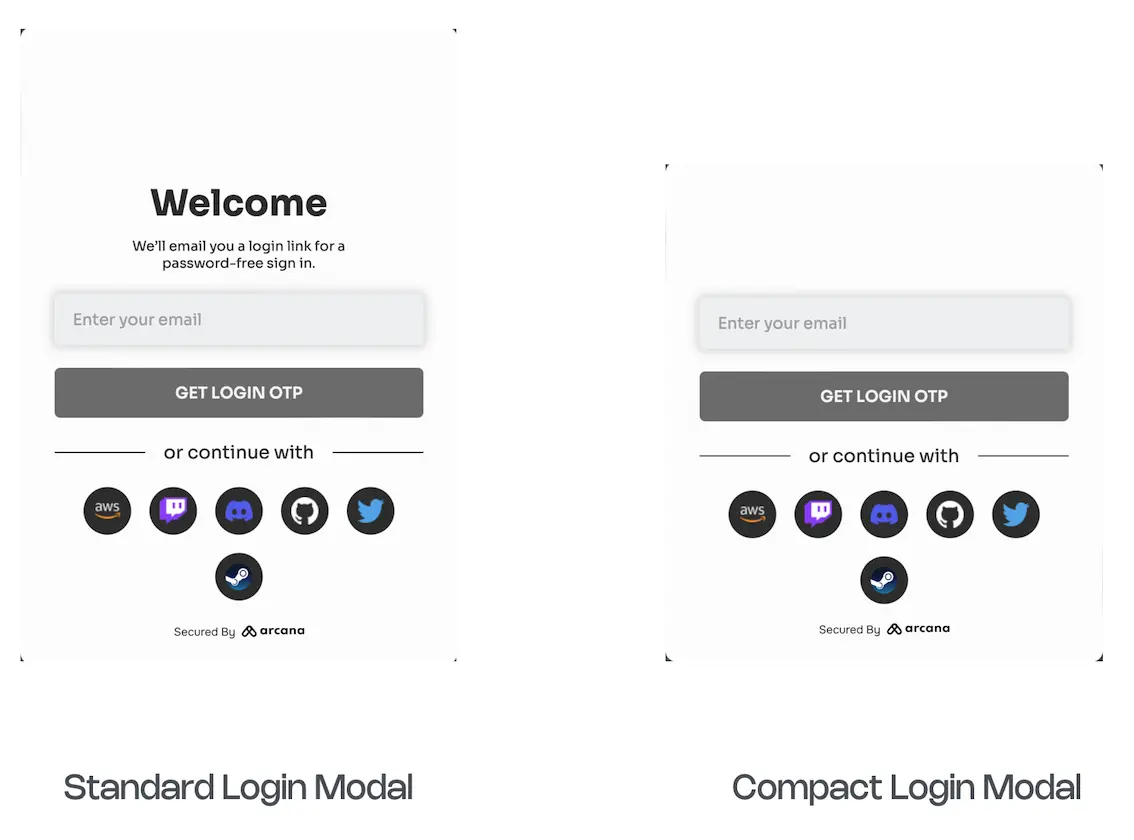Quick Start: Solana Apps
Estimated time to read: 2 minutes
'Solana' Web3 apps can easily onboard users via social login by integrating with the Arcana Auth SDK!
1. Register & Configure
Register the app as instructed in the Solana Configuration Guide and obtain a unique Client ID. Configure social login provider to onboard users and customize the user experience for blockchain signing via the wallet settings. Solana chains are pre-configured and instantly accessible to authenticated users via the Arcana wallet.
2. Install SDK
For 'Solana' app, install the auth package.
npm install --save @arcana/auth
yarn add @arcana/auth
<script src="https://cdn.jsdelivr.net/npm/@arcana/auth"></script>
<script src="https://unpkg.com/@arcana/auth"></script>
Use latest SDKs
Use the latest Arcana Auth SDK release: v1.0.11. Migrate from Arcana Auth SDK v1.0.10 -> v1.0.11.
Versions older than Arcana Auth SDK v1.0.10 may encounter potential breaking changes that require app reconfiguration, integration code updates, and redeployment. Refer to the Migration Guides and Release Notes.
3. Integrate
Import AuthProvider from the auth package.
import { AuthProvider } from '@arcana/auth'
Create a new AuthProvider, specify the unique Client ID obtained earlier during app registration.
const auth = new AuthProvider(
"xar_live_445007f942xxxxxxxxxxxxxxxxxx484cAfd2", // App client ID
{
position: 'left', // default: right
theme: 'light', // default: dark
setWindowProvider: true, // default: false, window.ethereum not set
connectOptions: {
compact: true // default: false, regular plug-and-play login UI
},
})
Initialize the newly instantiated AuthProvider.
try {
await auth.init()
} catch (e) {
// Handle exception case
}
Initialize First!
The app must use await until the init() call is complete, before invoking any of the other Arcana Auth SDK functions.
AuthProvider Optional Parameters
Besides Client ID input parameter, you can optionally customize these settings in the AuthProvider constructor:
position: wallet position within the app context - left|right
theme: wallet theme - light|dark
connectOptions: built-in login UI compact mode - true|false
See AuthProvider constructor parameters for details.
After initializing the AuthProvider, you can call any of its exported functions. See Arcana Auth SDK Reference Guide for details.
Initialize Providers
Solana apps can use the auth.provider to make standard JSON RPC calls in the context of an authenticated user.
const { AuthProvider } = window.arcana.auth // From CDN
//or
import { AuthProvider } from '@arcana/auth' //From npm
const auth = new AuthProvider(
"xar_live_445007f942xxxxxxxxxxxxxxxxxx484cAfd2", // App client ID
{
position: 'left', // default: right
theme: 'light', // default: dark
alwaysVisible: false, // default: true, wallet always visible
setWindowProvider: true, // default: false, window.ethereum not set
connectOptions: {
compact: true // default: false, regular plug-and-play login UI
},
chainConfig: { // Note: These values override dashboard settings during app registration
chainId: '1', // defaults to Solana Mainnet, use '2' for Testnet, '3' Devnet
rpcUrl: 'https://api.mainnet-beta.solana.com', // defaults to 'https://api.mainnet-beta.solana.com'
// Use 'https://api.testnet.solana.com' and https://api.devnet.solana.com' for Testnet, Devnet
},
})
try {
await auth.init()
} catch (e) {
// Handle exception case
}
const provider = auth.provider;
Use the Solana provider for issuing Solana Web3 wallet operations in the context of an authenticated user.
const { AuthProvider } = window.arcana.auth // From CDN
//or
import { AuthProvider } from '@arcana/auth' //From npm
const auth = new AuthProvider(
"xar_test_445007f942xxxxxxxxxxxxxxxxxx484cAfd2", // App client ID
{
position: 'left', // default: right
theme: 'light', // default: dark
alwaysVisible: false, // default: true, wallet always visible
setWindowProvider: true, // default: false, window.ethereum not set
connectOptions: {
compact: true // default: false, regular plug-and-play login UI
},
chainConfig: { // Note: These values override dashboard settings during app registration
chainId: '1', // defaults to Solana Mainnet, use '2' for Testnet, '3' Devnet
rpcUrl: 'https://api.mainnet-beta.solana.com', // defaults to 'https://api.mainnet-beta.solana.com'
// Use 'https://api.testnet.solana.com' and https://api.devnet.solana.com' for Testnet, Devnet
},
})
try {
await auth.init()
} catch (e) {
// Handle exception case
}
const solanaP = auth.solana;
Onboard Users
The built-in, plug-and-play login UI is enabled by default. To use it, just add a single line of code in the app, call the connect function of the AuthProvider.
await auth.connect();
This will bring up the login modal displaying the onboarding options configured for the app in addition to the passwordless option.

Compact Login UI
You can choose to use a compact form of the built-in login UI modal instead of the regular one.
No plug-and-play support for Firebase authentication.
The plug and play feature of the Arcana Auth product is not supported for Firebase. Developers must build a custom login UI and add code to onboard users. For details, see onboarding users via Firebase and custom login UI
Custom Login UI
You can onboard users through a custom login UI instead of the built-in plug-and-play one. See how to use custom login UI for onboarding users in a 'Solana' app for details.
Arcana JWT Token
Upon successful authentication, Arcana Auth SDK returns a unique JWT token to the app called the Arcana JWT Token. App developers can access this token via getUser() method and refer to the loginToken field of the UserInfo object.
Developers can use this token to verify the user and subsequently generate another token for app use if required.
In the future, the Arcana JWT Token will be deprecated. Use userDIDToken to verify user.
Upon successful authentication, Arcana Auth SDK returns a unique DID token to the app called the Arcana DID Token. App developers can access this token via getUser() method and refer to the userDIDToken field of the UserInfo object.
Developers can use this token to verify the user and subsequently generate another token for app use.
Sign Transactions
Use the standard EIP-1193 provider, auth.provider, for issuing Solana JSON-RPC calls in the context of the authenticated user. Use auth.solana Solana provider for issuing supported Web3 wallet operations on the Solana chain.
4. Deploy
That's all!
Your 'Solana' app is now powered by Arcana Auth SDK to onboard users via social login and allow authenticated users to sign blockchain transactions using the Arcana wallet.
See Also
- 'Solana' integration example:
'sample-auth-solana'submodule in Auth Examples - Arcana Developer Dashboard User Guide
- Configuring Arcana wallet visibility
- Developer's Guide for Arcana wallet
- Handling Arcana Auth SDK error messages
- Arcana Auth SDK Usage Guide
- Arcana Auth SDK Reference Guide
- Arcana Auth Wagmi SDK Reference Guide
- Arcana Auth Flutter SDK Reference Guide
- Enabling Gasless Operations in an App
- Arcana Gasless (Standalone) SDK Quick Start Guide
- Arcana Gasless (Standalone) SDK Usage Guide
- Gasless Error Messages
Arcana Auth SDK Quick Links
